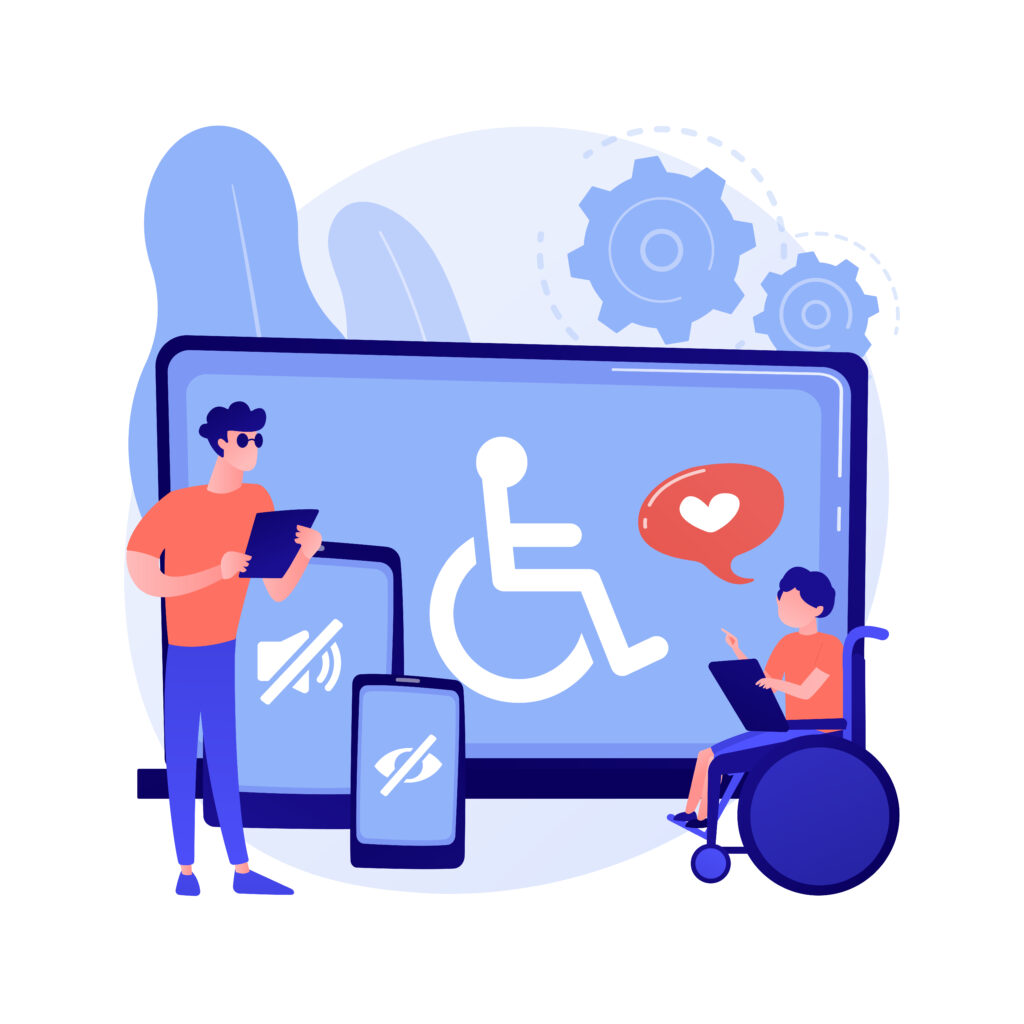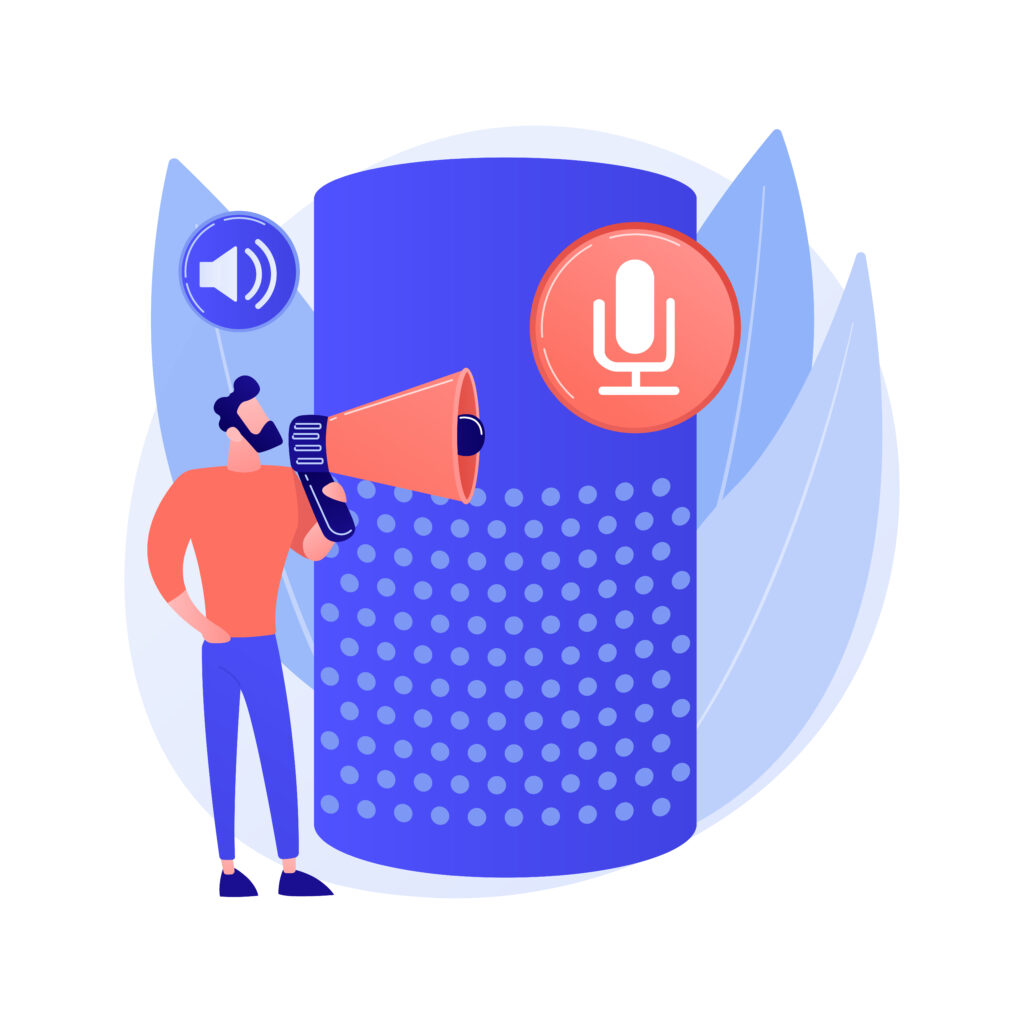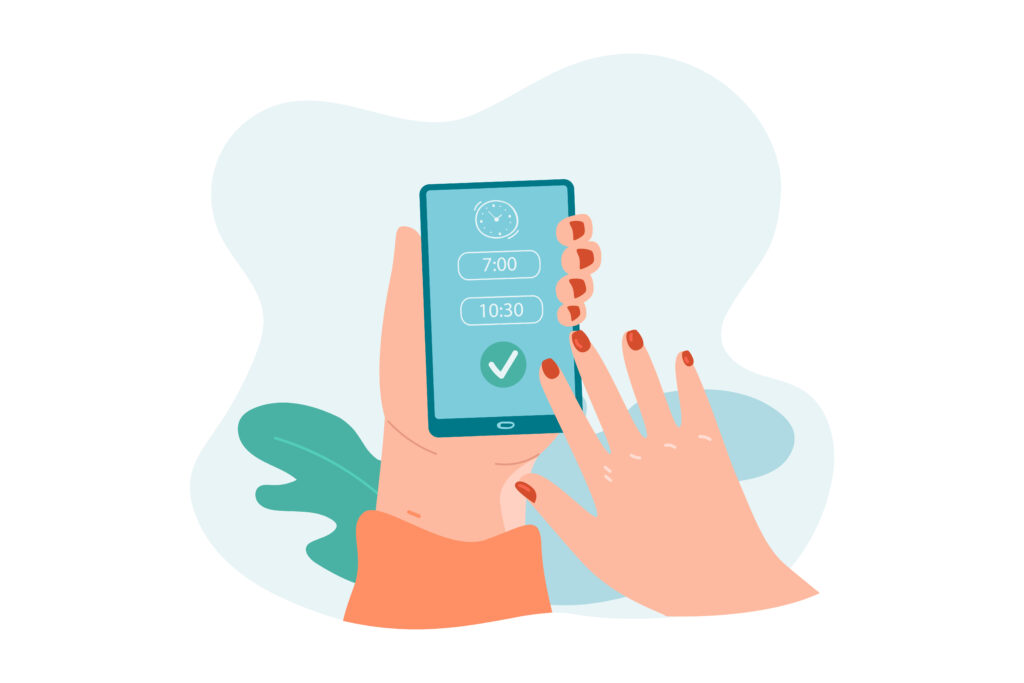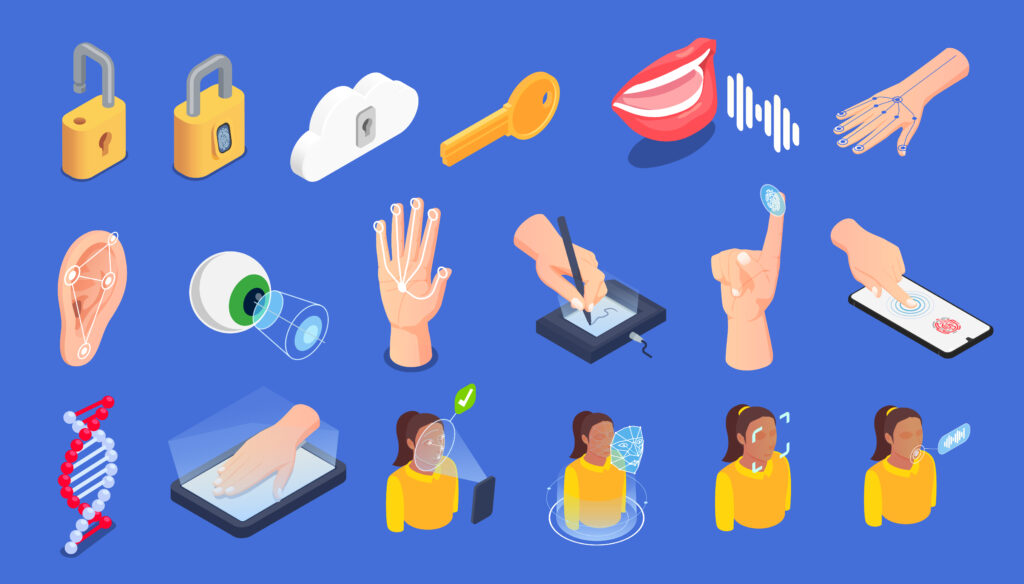According to the World Health Organization, one billion people (over 15% of the world's population) live with some form of disability. These potential users must be taken into account in the search for users. Involving people of different skills, from different cultures and backgrounds, and from different parts of the world allows for the most inclusive design possible.
Inclusive design aims to make a product or service accessible and functional to as many people as possible, regardless of their physical, mental or social characteristics. It is essential for businesses as it helps them reach previously overlooked customer segments.

1 – Accessibility for an inclusive design
Accessibility is one of the elements of inclusive design, as both aim to achieve the same goal, which is to create products that are suitable for a wide range of people. Accessibility, on the other hand, refers to whether or not there are literal barriers that prevent a person from experiencing something.
To do this, the World Wide Web Consortium (W3C)) has developed four Web Content Accessibility Principles (WCAG): Perceptible, Usable, Understandable, Robust. Regardless of technological developments, these basic principles will always remain applicable.
Recently, I had the opportunity to work on a medical research mobile application project for people with cognitive and dexterity disorders. I find that on the one hand, these people are not often included in user research, their behaviors, needs and problems are little known to companies. On the other hand, thanks to technology, there are many tools to help these people to make it easier for them to use the products on a daily basis.

2 – Artificial intelligence, a constantly evolving solution
AI has the potential to solve some of the toughest challenges in the world, but only if the algorithms and data that power it are reliable and unbiased. Concretely, what can AI do for accessibility? It can remove barriers to accessibility through different solutions:
- Image recognition and facial recognition for people with visual impairments,
- Speech-reading recognition for people with hearing impairments,
- The text summary for people with mental disabilities,
- Real-time subtitling or translation for people with hearing impairments or even people who don't speak the language.
AI has a huge impact on the daily life of people with disabilities, a person with a mental disability can easily understand the world around him. Things that were initially difficult or impossible for them are now easily accessible on a daily basis. AI allows people with disabilities to enter a world where their difficulties are understood and taken into account. Technology is adapting and helping to transform the world into an inclusive place through the accessibility of artificial intelligence.
There are many technologies using Artificial Intelligence to integrate an accessible and inclusive design, here are some detailed examples below.

3 – Voice command, a new standard
Voice control and voice interfaces are one of the most important developments in recent years. They have gradually moved from a new way of searching for information on Google to a standard way of human-computer interaction. We find this type of technology via tools such asAlexa, Google Assistant or Crab.
The forecast indicates that the voice and speech recognition market is expected to grow at an CAGR of 17,2% to reach $26,8 billion in 2025.
The voice interface allows people to request information just by speaking, without the need to type. Therefore, this technology helps to simplify and optimize the search process, which improves the user experience and makes the environment more accessible for people with cognitive or dexterity impairments. This means of human-computer interaction allows users to perform searches much faster while reducing cognitive load and friction.
The voice interface uses speech recognition and natural language processing technologies to transform the user's speech into meaning and, eventually, commands.
4 – Lip reading for hearing impaired users
Lipreading automation algorithms are very similar to captioning algorithms and can be helpful for people with hearing loss.
DeepMind from Google is at the forefront of this AI technology. After analyzing over 5000 hours of TV shows, DeepMind can identify specific lip movements for certain words with an accuracy rate of 46,8%, allowing it to convert speech to text in real time.
Le projet Euphonia from Google is another technology in this area. It uses artificial intelligence to help decode human speech. People with atypical diction can provide voice samples to help the AI learn to understand more diverse ways of speaking. This data can be used to advance voice recognition, giving more people the opportunity to use voice command technology in the future.
5 - Google Look to Speak for users with speech impairment
look to speak is an app that lets you choose from a list of phrases using only eye movement, the app then speaks those phrases out loud. It is designed to help people with motor and speech difficulties to communicate more easily.
With this app, just look left, right, or up to quickly select what you want to say from a list of phrases. Words and phrases can be personalized, allowing people to share their true personality. Gaze detection settings can be adjusted.

6 – Apple's AssistiveTouch for users with reduced dexterity
Dexterity, vision and cognition: these senses must be taken into account when designing digital products. If they decrease, the experience is affected. Seniors, for example, are the main users affected by these disorders. Today in France, 69% of them now own a smartphone. It is important to include them in research and user experience.
THEAssistiveTouch from Apple is an accessibility feature of iOS where a virtual button can be placed on the device screen. This feature first appeared in iOS 5 in 2011, then was added to watchOS 8 in 2021.
Although this accessibility feature is developed with people with physical limitations in mind, anyone can take advantage of this useful tool to perform tasks like summoning Siri, pressing the side button, and even paying with Apple. Pay in a more convenient way. In addition, it also offers the flexibility to associate each gesture with a specific action. AssistiveTouch, however, is designed to work more effectively, in conjunction with third-party accessories, to help people with disabilities use an iPhone or iPad. Thus, they can use all the functions of an iOS device without having to touch the screen or press the buttons of the device.
7 - Seeing AI for visually impaired users
Another good example of sense dysregulation is low vision or blindness, which can affect the functionality and emotional impression of a design. There is a preconceived idea that smartphones are less accessible to people with visual impairments, since they rely heavily on more or less good visual function. However, in recent years, mobile technology has integrated advanced computing functions that use sound, haptics and gestures to interact with smartphones, thus replacing visual interaction, making all digital content on smartphones accessible to people with these disabilities.
Thus, Microsoft has developed Seeing AI, an app that identifies objects in the environment for people who are blind or visually impaired. It works with money, products, people, and small amounts of text. Since its launch in July 2017, the app has independently completed more than 7 million tasks and has been downloaded by 200 users.
Android users have a similar app called TapTapSee which describes everything the user takes a picture of.
Other better-known applications, such as VoiceOver or TalkBack, are screen readers, whose primary use is to speak any email or text message. They use AI to describe app icons, battery level, and even partial images.
8 – Accessibility for all users
Although we've focused on users with disabilities, the inaccessible design choices can be uncomfortable for users of all ages and types. For example, a Nielsen Norman study of teenage users found that they "don't like tiny fonts as much as adults do."
In addition to assistive technologies, one suggested solution is that of parallel experiences. A parallel experience is a design solution for users at different levels of digital and technical experience, allowing them to change their preference setting at any time. The entire user experience adapts to the selected level. The advantage of parallel experiences is that all users can use the same devices. Another advantage is the personalization of the user according to his physical or mental handicaps.
Inclusive design is fast becoming a mandatory part of any UX and UI Designer's thought process. Companies that rely on Inclusive Design in the creation of their products will primarily reap the benefits. By opening their products to nearly a billion people with disabilities, these companies will quickly have a clear advantage over the competition. Fortunately, there are many tools to help you make your digital products more accessible.
These online tools are listed by The A11Y Project. Aids that will be useful to you throughout the development cycle of your product. Chrome also offers a wide range of extensions to test your accessibility, including AXE et devTools.
# - References
Voice Search and Voice Interfaces 101 by Adam Fard (Jul 2022)
https://uxmag.com/articles/voice-search-and-voice-interfaces-101-banner
How to Design for Human Aging: 5 Methods for Inclusive Digital Experiences by Alina Karl (June 2022)
https://uxmag.com/articles/how-to-design-for-human-aging-5-methods-for-inclusive-digital-experiences
Tech Adoption Climbs Among Older Adults by PEW RESEARCH CENTER (May 2017)
https://www.pewresearch.org/internet/2017/05/17/tech-adoption-climbs-among-older-adults/
Designing Technology With The Older Population In Mind by Sarah Kurdoghlian (March 2020)
https://uxdesign.cc/designing-technology-with-the-older-population-in-mind-8a6a4f920bec
UX and the Importance of Web Accessibility by Laura Geley
https://www.toptal.com/designers/ui/importance-web-accessibility
Principles of Inclusive Design by Johnny Levanier
https://99designs.fr/blog/conseils-design/design-inclusif/
Inclusive Design by Microsoft
UX/UI Design: 5 golden rules for using Inclusive Design (Nov 2022)
https://graphiste.com/blog/regles-utiliser-inclusive-design/
A Human-centered take on Seniors and Technology by MahsaYavari (Jul 2017)
https://medium.theuxblog.com/a-human-centered-take-on-seniors-and-technology-7d3e02c2f5f9
IPHONE ASSISTIVE TOUCH REVIEW (June 2020)
https://www.iphonetricks.org/iphone-assistive-touch-review/
HOW TO USE SWITCH CONTROL TO OPERATE YOUR IPHONE (Av 2015)
https://www.iphonetricks.org/how-to-use-switch-control-to-operate-your-iphone/
Best smartphone assistive apps for seniors with low vision by Riya Anne Polcastro (Jul 2022)
https://www.seasons.com/best-smartphone-assistive-apps-for-seniors-with-low-vision/2614168/
Design for the Blind by Oscar Gonzalez (Sept 2022)
https://uxmag.com/articles/design-for-the-blind
Artificial Intelligence and Accessibility: Examples of a Technology that Serves People with Disabilities by Carole Martinez (Dec 2021)
AI for disability inclusion by Accenture
https://www.accenture.com/_acnmedia/PDF-155/Accenture-AI-For-Disablility-Inclusion.pdf
Smartphones-Based Assistive Technology: Accessibility Features and Apps for People with Visual Impairment, and its Usage, Challenges, and Usability Testing by Suraj Singh Senjam, Souvik Manna and Covadonga Bascaran (Nov 2021)
https://www.ncbi.nlm.nih.gov/pmc/articles/PMC8636846/
How Artificial Intelligence is Improving Digital Accessibility by Benjamin Roussey (Oct 2022)
https://www.accessibility.com/blog/how-artificial-intelligence-is-improving-digital-accessibility
Look to Speak helps people communicate with their eyes by Richard Cave (Dec 2020)
https://blog.google/outreach-initiatives/accessibility/look-to-speak/
Leslie DJAOUAL, UX Designer @UX-Republic
Our next trainings
UX-DESIGN: THE FUNDAMENTALS # Paris
SMILE Paris
163 quay of Doctor Dervaux 92600 Asnières-sur-Seine
VISUAL THINKING: CONCRETE YOUR IDEAS # Paris
UX-REPUBLIC Paris
11 rue de Rome - 75008 Paris
DIGITAL ACCESSIBILITY AWARENESS #Paris
SMILE Paris
163 quay of Doctor Dervaux 92600 Asnières-sur-Seine
DIGITAL ACCESSIBILITY AWARENESS #Belgium
UX-REPUBLIC Belgium
12 avenue de Broqueville - 1150 Woluwe-Saint-Pierre
ACCESSIBLE UX/UI DESIGN # Paris
SMILE Paris
163 quay of Doctor Dervaux 92600 Asnières-sur-Seine
AWARENESS OF DIGITAL ECO-DESIGN # Belgium
UX-REPUBLIC Belgium
12 avenue de Broqueville - 1150 Woluwe-Saint-Pierre
STORYTELLING: THE ART OF CONVINCING # Paris
SMILE Paris
163 quay of Doctor Dervaux 92600 Asnières-sur-Seine
UX/UI ECO-DESIGN # Paris
SMILE Paris
163 quay of Doctor Dervaux 92600 Asnières-sur-Seine
DESIGN THINKING: CREATING INNOVATION # Belgium
UX-REPUBLIC Belgium
12 avenue de Broqueville - 1150 Woluwe-Saint-Pierre











